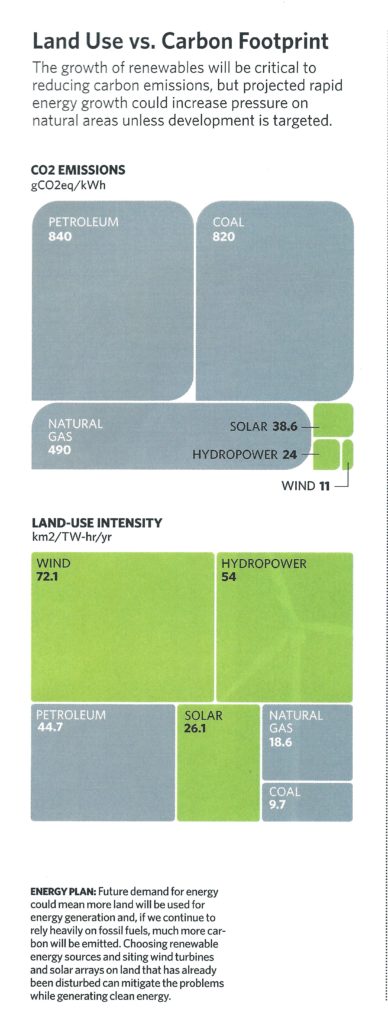“Energy Sprawl”
That’s the title of a feature article in Nature Conservancy magazine’s Fall issue.
 What really drew my attention to the article is the Land Use vs. Carbon Footprint graphic shown here. Good info, easy to take in. And, something I hadn’t really considered.
What really drew my attention to the article is the Land Use vs. Carbon Footprint graphic shown here. Good info, easy to take in. And, something I hadn’t really considered.
The piece starts with a 2-page photo (as if to emphasize the title) showing what’s called “part” of the Port of Rotterdam’s petroleum footprint. Petroleum storage containers as far as one can see in the pix, wind turbines, railways, bridges, canals and a long trail of smoke stack effluent in the distant background. Totally industrial.
The accompanying caption reads: “Growing energy demand could threaten 20 percent of the world’s remaining natural land by 2030.” According to author Joseph Kiesecker, that equates roughly to the size of Russia. For U.S. wind power, an area the size of S. Dakota will be needed by 2040. These are dramatically larger footprints than what coal requires, and still larger than petroleum.
“But one [Nature Conservancy] scientist has a vision for getting the energy we need without sacrificing nature [italics mine]”. That’d be Kiesecker.
A plan is needed for all corners of the earth. Conservation-informed planning is one initiative of The Nature Conservancy (TNC) offered globally to regional energy companies and municipal governments.
Generally, the key is to site renewable energy infrastructure on land that’s already disturbed. Places include ag land, industrial areas and former mine sites (think mountaintop mining). Another is capped landfills. Yet another is, of course, rooftops–like those housing big box stores, schools and transportation and industrial distribution buildings.
One example cited is TNC’s work back in 2010 where it mapped out the Mohave Desert region’s most biologically diverse and unspoiled places for protection. One beneficiary of that effort is the desert tortoise. Industrial development has been steered away from its habitats there.
Also identified by the work that included industry and government reps is 1.4m acres of previously developed (old ranchlands) or degraded sites (abandoned mines) that will readily support solar infrastructure in the Mohave.
In developing countries such as India, Kiesecker points the way toward a dispersed model of renewable power generation. Rooftop use and smaller land-based facilities for solar will be key for decentralized smart grids in areas already well populated.
“While it is bad news that wind, solar and biofuels all have a larger footprint on the land than fossil fuels, one of the great advantages of most renewable sources is that we can put them just about anywhere,” Kiesecker says.
“Some places may be sunnier or windier than others, but renewables aren’t as tightly linked to a specific patch of ground as fossil fuels…,” he adds.
Globally, for the siting of renewable energy systems, there’s plenty of previously disturbed land or rooftop acreage the use of which would have the effect of maintaining critical conservation needs for a heathier ecosystem and planet. Let’s go there.
